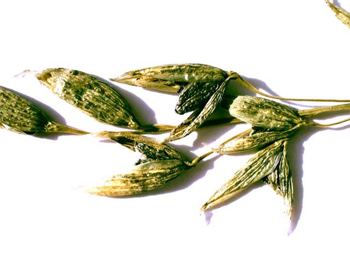Diseases
Ustilago kolleri Wille - Covered Smut of Oats.
Synonym.
Ustilago levis (Kell. et Swing.) Magn.Systematic position.
Class Basidiomycetes, subclass Teliobasidiomycetidae, order Ustilaginales, family Ustilaginacea, genus Ustilago.Biological group.
Biotroph.Morphology and biology.
U. kolleri infects Avena species. Species of Bromus, Hordeum and Agropyron may also be infected. Disease is apparent as inflorescence emerge. The plant may be slightly stunted, having hard, compact, upright, and smutted panicles. The smut balls are covered with a membrane that remains intact. Sometimes narrow strips of sporiferous fungus are observed on upper leaves. The life cycle and the symptoms caused by U. kolleri are similar to those of U. hordei (pathogen of Covered Smut of Barley). Teliospores from smutted panicles may be released by harvesting operations and mixed with oat seeds in a harvester. The infection is kept under seed coat as spores, gemmae, or dormant micelium. Germination of teliospores results in the infection of the inner seed coat. Infection of the seedling by the dormant fungus structures occurs by penetration into the seedling axis. Then the pathogen develops in the meristem of the oat host, ultimately invading and replacing the tissues of all flowers of infected panicles. Teliospores are spherical, deep-brown, 4.6-8.1 um in diameter, and always smooth, in contrast to U. avenae spores.Distribution.
Loose Smut occurs on oats in different countries of Europe, Asia, America, and Australia, where oat is cultivated. In Russia it is found in all regions where oats are cultivated. At the same time Covered Smut is registered much less often than Loose Smut. Over the past decades it has been replaced by U. avenae in many regions, where U. kolleri was regularly recorded in the past. Thus, despite the common wide distribution, zones of possible harmfulness are limited. During the last decades U. kolleri has been registered in Northern Volga Basin region, Western Siberia, Northern Kazakhstan, the Far East, and some other areas.Ecology.
Teliospore germination and seed infection starts at temperatures of 6 to 10 degrees C. U. kolleri is less heat tolerant than U. avenae. As a result U. kolleri is more harmful in Siberia and regions of temperate climate in the European part of its area. Temperatures 20 . 25 degrees C and humidity 100% are optimal for infection structured germination.Economic significance.
In favorable conditions the Covered Smut may infect 10% or more plants. In this case, the damage consisting of both direct losses and losses related to depression of outwardly healthy plants may be appreciable. However, it is not now possible to consider it as an essentially dangerous disease because of the small geographic range of the Covered Smut distribution. Control measures include resistant varieties and seed treatment.Reference citations:
Anonymous. 1999. Smuts of rye, oats and barley. Zashchita rastenii i karantin, 7: 31. (In Russian)Ishkova T.I., Berestetskaya L.I., Gasich E.L., Levitin M.M., Vlasov L.Iu. 2002. Diagnostics of the main fungus diseases of cereal crops. St. Petersburg: VIZR. 76 p. (In Russian)
Karatygin I.V. 1986. Smuts of cereal crops. Leningrad: Nauka. 112 p. (In Russian)
Levitin M.M., Tuterev S.L. 2003. Fungal diseases of cereals crops. Zashchita rastenii i karantin, 11: 77. (In Russian)
Rudenko D.K., Grisenko G.V. 1966. Cereals smut. Distribution of pests and diseases on agricultural crops in 1965. Leningrad: VIZR. 131-142 p. (In Russian)
Timoshenko Z.V. 1973. Occurrence of oat-affecting smut fungi in the USSR. Mikologiya i fitopatologiya, 7(4): 367-368. (In Russian)
Utesheva T.A. 1977. Distribution and harmfulness of oats smut in Northern Kazakhstan. Kazakhstana: Vestnik sel'skokhozyastvennoi nauki. V. 2: 49-52. (In Russian)
© Dmitriev A.P.


